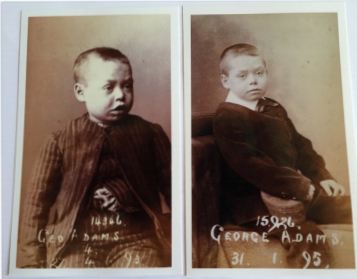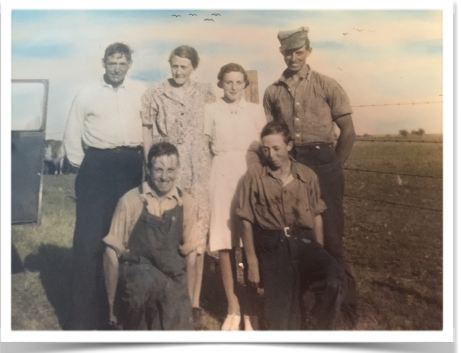 My husband and I have been together for over 20 years, share two children and live in an idyllic small town in Ontario. We are lucky to be close to his large extended family that live in and around this area. I have known my whole life that my mum was a Child Migrant and have spent the better part of the last two years researching her story and her family tree. She and I just completed a trip to England to revisit roots and find more answers to her life before she came to Canada.
My husband and I have been together for over 20 years, share two children and live in an idyllic small town in Ontario. We are lucky to be close to his large extended family that live in and around this area. I have known my whole life that my mum was a Child Migrant and have spent the better part of the last two years researching her story and her family tree. She and I just completed a trip to England to revisit roots and find more answers to her life before she came to Canada.
I had seldom heard stories that my father in-law would tell, about his father, and how he was sent to Canada as a small child and didn’t say much else.
It wasn’t until my father in-law handed me a beautiful, heavy bronze type of medallion or medal that I realized there was another story here that needed to be discovered. My father in-law’s father was named George Joseph Adams. He was a Barnardo boy.
Having made many connections with Child Migrant Advocacy Groups for the research on my mom’s story, I quickly found out that we could send away for George’s Barnardo file. We hoped to uncover some of the answers we never knew all my father in-law’s life, he is now 89 years old!
Following a simple email request and a payment to Barnardo’s, a kind woman trekked to the basement of what must be the largest filing cabinet in the world and unearthed a substantial file, labelled GEORGE JOSEPH ADAMS.
My father in-law never knew where his father came from, was it England or Ireland? Who were his fathers parents or if he had any siblings. Hopefully this would tell us all that important information.
The file arrived in the mail just two days before my father in-law was to go into the hospital for tests and possibly heart surgery. There was no time like now to find out the truth about his loving father, who sadly died when my father in law was fifteen years old. He was too young to ask all those important questions that you think about as you get older.
So, after looking at TWO wonderful photographs of George that came in the Barnardo file we were able to read what George’s story was. According to the initial report, upon his Admission to Barnardo’s, George was apparently picked up by a policeman on the street in the town of Burnley, Lancashire, England, on January 30, 1893. He was in the company of two men, Thomas Lowcock and Alexander Fraser, the first who claimed to be his father.
The two men were singing in the street, begging for money door to door with little George held by the hand. The policeman arrested the men and they were sentenced to one month hard labour in the Preston Jail
(this jail still exists and is known today for its extreme overcrowding).
Information given during Thomas Lowcock’s court testimony revealed that he has been living in adultery with a woman named Adams and that this woman had died in a workhouse. He said the boy was his and that he was tramping the country with him. Since George was illegitimate, Thomas
Lowcock was not allowed to keep him. It was clearly noted that George had no known relatives and his place of birth was not known.
What can most likely be certain is that George was English, not Irish.
He had brown hair, grey eyes, was 3 ft, 2 1/2 inches tall, fair completion and weighed 39 pounds. He was approximately four years old. (this would make his birth year 1889) George was taken to the Sheppard House, one of the Barnardo Children’s Homes in London, England. George lived in Barnardo homes from 1893 until 1900, changing homes a few times but no records
exists of his time there, other than a detailed list of homes he lived in.
April 26, 1893 – Admitted to the Receiving House
April 28, 1893 – Sent to Sheppard House
October 23, 1893 – Sent to the Infirmary
January 5, 1894 – Sent to the Convalescent Home
January 31, 1895- Boarding out to Aldingbourne , West Sussex
June 5, 1900 – Transferred to Stepney Home
July 19, 1900 – Sailed to Canada aboard the S.S. Tunisian
July 29, 1900 – Arrived in Montreal, Quebec
There is no information as to what ailment George suffered from that required him to go to the Infirmary and convalescent home. It was noted upon his admission that he had a greatly enlarged abdomen. Could this have indicated starvation? Infection? Appendix? George was sent to Canada as a Home Child where families could apply to receive a child, to usually
help on the farm or around the house. George was sent to “work” as an employee for a Mr. Henry S. Reed and his wife, in Dungannon. They were a childless couple who were in their mid fifties by this time. Barnardo’s called this “Boarding Out”. It was a trial period to see how the boy got on with the
family.
It is clear from the documentation that George and the Reed’s had to sign an “Agreement” where George would have to fulfill certain duties and obligations for a wage, and Mr. Reed would need to pay wages and give the child certain amenities. George would have signed this agreement when he was only eleven years old. On September 14, 1900, George signed the Agreement with Mr. Reed. It looks like Mr. Reed paid $100 and agreed that George would receive two terms of schooling. It also appears that he was paid $96 for the year, and George requested to have $20 for himself to save for the future.
 Mr. Reed helped him to open a bank account. Mr. Reed supplied him with ample clothing. A file was set up to document visits from a Barnardo Representative, and it seems like the visits were done annually and notes were always taken, though brief. With George arriving at the farm in Dungannon on July 30, 1900, the first report in the file on August 1,
Mr. Reed helped him to open a bank account. Mr. Reed supplied him with ample clothing. A file was set up to document visits from a Barnardo Representative, and it seems like the visits were done annually and notes were always taken, though brief. With George arriving at the farm in Dungannon on July 30, 1900, the first report in the file on August 1,
1900 recorded that George arrived safely and that “he thinks he has a nice place” Over the years the annual visits, documented by the Barnardo Representative indicate that George was thriving. He was learning all the jobs on the farm and was performing them well.
Early reports indicate that George was healthy, and that he was becoming useful to his employer and bears and excellent character. George appeared contented and comfortable in the Reed’s home. It is noted several times that George had good health, satisfactory conduct, and was a credit to the
Home (Barnardo’s) He went to school and had a good “local reputation”.
Mr. Reed agreed to keep George on, and as Mr. Reed was failing with rheumatism, George took over the farm duties. There is no mention of the wife at all. George comments several times to the Representative that he wondered what happened to his friend, from the home in England but they
reported back that they had no information on whatever became of that child. George must have sorely missed his friend because he inquired several times with no success.
On September 25, 1906, The Barnardo Representative gave George a Silver Medal for faithfully fulfilling his commitment to the Home and to his host family. George wrote to thank the organization, to say that he was pleased to receive it, that he was getting along very well with the Reeds, and can do
any kind of farm work now. He adds that he now weighs 126 pounds and his height is 5 foot 7 inches tall! He also indicated that he was very grateful to the Home for bringing him out to Canada, and is quite certain that he will never go back to England. These annual reports continue until George is 23 years old.
By around 1912, Mr. Reed was becoming crippled due to rheumatism. He is thinking of giving up farming and leaving George in charge of the farm. George is noted to be a good worker, he bears a good name, attends church and “is doing well in every way”. It is documented that by this time, George had saved a good deal of money. He married Leah May Standish, in Dungannon and together, they had four children – one of whom was my father in law.
George Joseph Adams died on June 17, 1943. He is buried in the Dungannon Cemetery. Interestingly enough, when he died, he had an insurance policy with Sun Life. Upon his death they wrote to Barnardo’s to confirm his age at the time he came to Canada. Barnardo’s wrote back indicating their condolences but wrote that should George have no relatives, they would appreciate receiving any estate that George would have left since they plucked him off the street and “were responsible for his upkeep for 10 years”
Sun Life was quick to respond that George did indeed have family and his will and estate were all in order, leaving the farm to his four children. Leah sadly died a few years before George.
I hold that big bronze medallion and read the inscription: Dr. Barnardo’s Homes – Presented to George Joseph Adams for good conduct and length of service. This medal must have meant a lot to him, since we still have it after all these years. I think we will frame it to remind future generations of “Adams” that they had a wonderful Grandfather, Great Grandfather, or Great Great……..I imagine that George must have been innately made of “good stuff”, to make the best out of his situation, as he grew to be a kind, loving husband and father. They raised four good, loving, hard working children, and I am lucky enough to be married to one of their children! My husband inherited his Grandfather’s work ethic, kindness and patience.
How proud can I be to know them and to be married into such an amazing family.? I am blessed that my children will carry on the “ADAMS” name, hopefully for generations to come.
